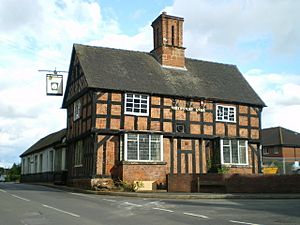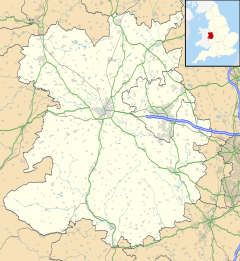Albrighton, east Shropshire facts for kids
Quick facts for kids Albrighton |
|
|---|---|
 The Shrewsbury Arms |
|
| Population | 4,326 (2011) |
| OS grid reference | SJ812041 |
| Civil parish |
|
| Unitary authority |
|
| Ceremonial county | |
| Region | |
| Country | England |
| Sovereign state | United Kingdom |
| Post town | Wolverhampton |
| Postcode district | WV7 |
| Dialling code | 01902 |
| Police | West Mercia |
| Fire | Shropshire |
| Ambulance | West Midlands |
| EU Parliament | West Midlands |
| UK Parliament |
|
Albrighton is a large village and civil parish in Shropshire, England. It is about 8 miles (13 km) northwest of Wolverhampton and 11 miles (18 km) northeast of Bridgnorth.
The village has its own train station on the Shrewsbury to Wolverhampton Line. It is also close to RAF Cosford, a Royal Air Force base, and the M54 motorway. Albrighton is the most easterly village in Shropshire. Just north of Albrighton is the small village of Donington, separated by a stream called Humphreston Brook.
Contents
A Look Back: Albrighton's History
Albrighton was first mentioned in the Domesday Book in 1086. It was called Albricston(e), which meant "the home or farm of Albric/Aethelbeorht."
Becoming a Borough
In 1303, Albrighton was given a special document called a charter. This charter made it a "Borough." This meant it had a local judge, called a Justice of the Peace. This was important because Albrighton was far from Shrewsbury, the county town of Shropshire. It was also near Staffordshire, and criminals would often escape there. Having a Justice of the Peace in Albrighton helped catch them. The charter was renewed in 1662.
A special club, called a Mace, was found in 1948. It confirmed Albrighton's old borough status. Local people helped buy it for the village.
Old Village Buildings
In the past, Albrighton had a small jail and stocks (a device used to punish people). These were near the Crown public house. A room above the pub was used for village meetings. There was also a Toll House nearby, where people paid fees.
An old article from 1884 said that the village fairs were held on a wide open space called the Cross. The Market Hall stood in the middle of this space, with the lock-up (jail) underneath it. It is not known when these buildings were taken down.
The Village Church
The main church in Albrighton is called St Mary Magdalene's. It was finished around 1181 and rebuilt a bit in 1853. It is made of red sandstone and built in the Norman style.
The church holds an alabaster monument and the Albrighton Mace. The Mace was given to the village in 1663 by Lady Mary Talbot. The church also has a 14th-century window. It is the burial place for many members of the Talbot family, including Charles Talbot, 1st Duke of Shrewsbury.
The church is very close to St Cuthbert's Church in Donington. A story says that two sisters disagreed about church design. So, they decided to build their own churches right next to each other! St Cuthbert's Church is also near St Cuthbert's Well, a special holy well.
Humphreston Brook
Humphreston Brook was dammed by a local miller in the 1600s. It now forms the border between Albrighton and Donington. The brook flows into Donington Pool, which is part of the Donington and Albrighton Nature Reserve.
Landowners and Industries
For much of the 1300s and 1400s, the Carles family owned Albrighton. Later, the Talbot family, who became the Earls of Shrewsbury, owned most of the land until 1918. Many of them are buried in Albrighton Church.
In the early 1600s, Albrighton was known for making buttons. In the 1700s, clock making became popular. By 1880, bricks were made here. But before the railways arrived, farming was the main job for most people.
Village Growth and Changes
In 1801, Albrighton had 900 people. By 1901, it grew to 1,200, and today it has over 4,000 residents.
The High Street has kept much of its old charm. It still has half-timbered inns, Georgian buildings, and lime trees. These trees were planted in the 1800s.
Gas came to Albrighton in 1868, and water in 1895. Electricity arrived in 1919. In 1967, a new road was built around the village to help with traffic.
Community Life
The village green was a very important place in the early 1900s. It had swings, and political meetings were held there. Bands also gave concerts on the green.
In 1969, David C.H. Austin opened the David Austin Plant Centre on the edge of the village. This center is famous worldwide for its roses and is a popular place for tourists to visit.
In 1998, Albrighton gave the Officers and Men of RAF Cosford the right to march through the village. This is a special honor, similar to the "Freedom of a City." Every two years, RAF Cosford staff parade down the High Street.
How Albrighton is Governed
Albrighton has an electoral ward (a local voting area). This ward includes the parish of Donington. In 2011, the total population of this area was 4,628.
Interesting Facts (Trivia)
- Around 1840, the famous writer Charles Dickens wrote about Tong Church while staying at a local pub, now called The Harp.
- In 1962, actor Jason Watkins was born in Albrighton. He is known for his role as DS Dodds in the TV show McDonald and Dodds.
- In July 1992, TV presenter Anneka Rice and her show Challenge Anneka came to Albrighton. They built a fishing pool for people with disabilities, called the Albrighton Moat Project. She returned in 2017 to celebrate its 25th anniversary.
- In the summer of 2006, a big storm caused parts of the village to flood.
Schools in Albrighton
Albrighton has five places for education:
- Albrighton and Donington Nursery
- St Mary's Church of England Primary School
- Albrighton Primary School
- Birchfield School
- St Mary's Nursery Group
Getting Around (Transport)
| Route | Destination | Operator | Notes |
|---|---|---|---|
| 891 | Telford & Wolverhampton | Banga Buses | Runs every hour Monday to Friday, and every two hours on Saturdays. No service on Sundays or bank holidays. |
Places to Visit (Amenities)
The village has four pubs:
- The Crown, Albrighton
- The Old Bush, Albrighton
- The Shrewsbury Arms, Albrighton (originally called the Talbot Inn)
- The Harp
Social clubs include:
- Albrighton Sports and Social Club (closed in 2020 for new development)
- Albrighton and District Rotary Club
- Albrighton Cricket Club
- Albrighton Tennis Club
- Royal British Legion
- Albrighton Bowling Club
- Albrighton Football Club
The Red House in Albrighton has been a community center for over 50 years. In 2021, it received the Queen's Award for Voluntary Service. This was for its volunteers' help during the Covid pandemic. They turned the parish minibus into a mobile shop to deliver food and other items.
Famous People from Albrighton
The well-known gardener and rose expert, David C. H. Austin, was born in Albrighton.
Special Honors (Right of Approbation)
The "Right of Approbation" is a special honor given by the Albrighton Village Council. It is similar to the "Freedom of the City" that towns and cities can give. Villages in the UK are not legally allowed to use the term "Freedom of the Village."
Military Units Honored
- RAF Cosford: Honored in 1998.
Images for kids
See also
 In Spanish: Albrighton para niños
In Spanish: Albrighton para niños








